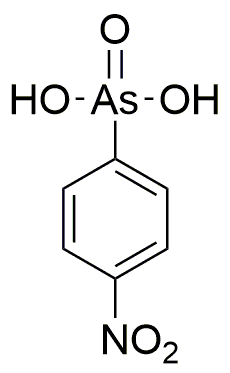Nitarsone is widely utilized in research focused on:
- Poultry Industry: It is commonly used as a feed additive to promote growth and improve feed efficiency in poultry, helping farmers enhance production while maintaining animal health.
- Veterinary Medicine: Nitarsone has applications in treating certain parasitic infections in livestock, providing an effective solution for veterinarians to manage animal health.
- Environmental Research: It is employed in studies assessing the impact of arsenic compounds on ecosystems, aiding researchers in understanding contamination and developing remediation strategies.
- Analytical Chemistry: Nitarsone serves as a standard in various analytical methods to detect and quantify arsenic levels in environmental samples, ensuring compliance with safety regulations.
- Pharmaceutical Research: Investigations into the potential therapeutic effects of nitarsone are ongoing, with the aim of exploring its role in treating certain diseases, particularly those related to cellular growth.
General Information
Properties
Safety and Regulations
Applications
Nitarsone is widely utilized in research focused on:
- Poultry Industry: It is commonly used as a feed additive to promote growth and improve feed efficiency in poultry, helping farmers enhance production while maintaining animal health.
- Veterinary Medicine: Nitarsone has applications in treating certain parasitic infections in livestock, providing an effective solution for veterinarians to manage animal health.
- Environmental Research: It is employed in studies assessing the impact of arsenic compounds on ecosystems, aiding researchers in understanding contamination and developing remediation strategies.
- Analytical Chemistry: Nitarsone serves as a standard in various analytical methods to detect and quantify arsenic levels in environmental samples, ensuring compliance with safety regulations.
- Pharmaceutical Research: Investigations into the potential therapeutic effects of nitarsone are ongoing, with the aim of exploring its role in treating certain diseases, particularly those related to cellular growth.
Documents
Safety Data Sheets (SDS)
The SDS provides comprehensive safety information on handling, storage, and disposal of the product.
Product Specification (PS)
The PS provides a comprehensive breakdown of the product’s properties, including chemical composition, physical state, purity, and storage requirements. It also details acceptable quality ranges and the product's intended applications.
Certificates of Analysis (COA)
Search for Certificates of Analysis (COA) by entering the products Lot Number. Lot and Batch Numbers can be found on a product’s label following the words ‘Lot’ or ‘Batch’.
*Catalog Number
*Lot Number
Certificates Of Origin (COO)
This COO confirms the country where the product was manufactured, and also details the materials and components used in it and whether it is derived from natural, synthetic, or other specific sources. This certificate may be required for customs, trade, and regulatory compliance.
*Catalog Number
*Lot Number
Safety Data Sheets (SDS)
The SDS provides comprehensive safety information on handling, storage, and disposal of the product.
DownloadProduct Specification (PS)
The PS provides a comprehensive breakdown of the product’s properties, including chemical composition, physical state, purity, and storage requirements. It also details acceptable quality ranges and the product's intended applications.
DownloadCertificates of Analysis (COA)
Search for Certificates of Analysis (COA) by entering the products Lot Number. Lot and Batch Numbers can be found on a product’s label following the words ‘Lot’ or ‘Batch’.
*Catalog Number
*Lot Number
Certificates Of Origin (COO)
This COO confirms the country where the product was manufactured, and also details the materials and components used in it and whether it is derived from natural, synthetic, or other specific sources. This certificate may be required for customs, trade, and regulatory compliance.


